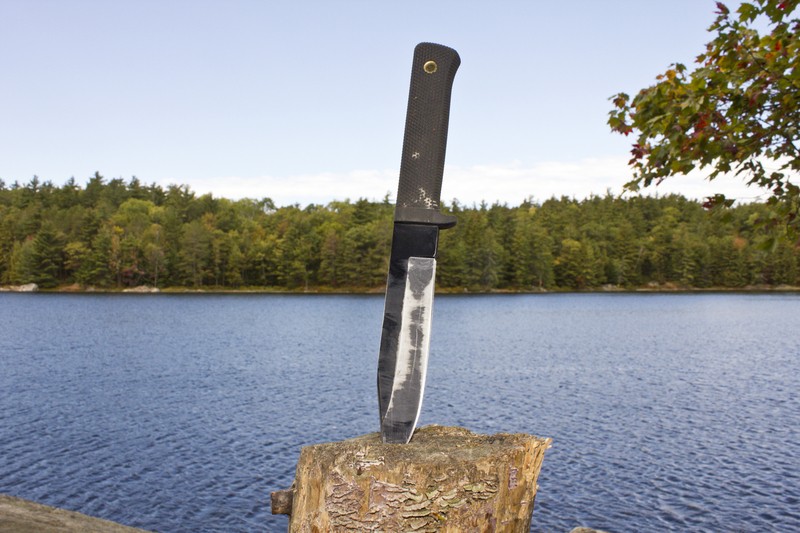Knowing what to look for in a survival knife can be a daunting prospect. There are so many choices out there that it's important to keep in mind some important keys to a good survival knife. Check out the article below to learn exactly what you should look for when selecting the tool that's going to keep you alive.
A “survival knife” is just as it sounds–a knife that can help you survive. It is a tool with literally hundreds of survival-related functions. Below is a short list:
Cutting/Slicing
Digging
Splitting
Self-Defense
First Aid Tool
Food Prep
Shelter Building
Fire Making
Hunting Weapon
Prying Tool
Signaling
Hammering
Make-Shift Screwdriver
When it comes to your survival knife, less is typically more–despite what you may see on TV. Hang the cool movie prop knife on a wall and embrace the simplicity of a skillfully designed survival knife. Function trumps styling–always. Your first priority is performance and that will depend on a variety of time-tested key features.Survival Knife Feature #1: Size
Does size matter? Yes, but when it comes to your survival knife, bigger is not always better. If your blade is too big, you sacrifice the ability to effectively use it for detailed tasks such as dressing small game or carving precision snare sets.
On the flip-side, a small blade does not perform well with more rugged tasks such as batoning and chopping. Batoning is when you strike the back of your knife blade with a heavy object to drive the knife through thick or stubborn wood. This allows the blade to be used for splitting wood and cutting through large limbs and trees.
Having used many survival knives, I’ve found the ideal size to be around 9-11 inches in length.Survival Knife Feature #2: Fixed Blade
A fixed blade knife is more durable and reliable than a folding knife. While I love a good folder for Every Day Carry (EDC), a fixed blade has the upper hand when it comes to meeting the demands a survival situation might present.
A joint of any kind is a weakness. Minimize the risk of damaging or losing your key survival resource by choosing a knife that is better suited for pounding, chopping, thrusting, prying, and rigorous cutting.Survival Knife Feature #3: Full Tang
Not only should your survival knife be a fixed blade, but it should also be FULL TANG. “Full tang” indicates that the blade and handle are constructed from one continuous piece of metal. Scales or grips are typically attached to the handle portion for a more comfortable grip.
Over time, partial tang knife blades can loosen and develop “play” in the handle–especially under demanding tasks such as batoning, prying, and chopping. In contrast, a full tang knife blade is still very functional even if the scales come off. It can be wrapped with cordage for added comfort and grip.Survival Knife Feature #4: Sharp Pointed Tip
This may seem obvious, but I’ve seen many “survival knives” with angled, rounded, hooked, or straight cut flat tips. Anything other than a sharp spear point tip compromises your ability to effectively thrust or stab your knife as a weapon–especially through thick fur/hide or layered clothing.Survival Knife Feature #5: Single-Edged Blade with Flat Ground Spine
Your survival knife should not have a double-edged dagger style blade. A double-edged blade is just not necessary for the vast majority of (if not all) survival uses. Actually, it can be a disadvantage.
A flat ground spine is ideal for striking a fire-starting ferro-rod. Rounded or beveled spines make this almost impossible.
I regularly use my survival knife to baton through large pieces of wood. Whether splitting firewood or constructing make-shift shelters, a sharpened back edge would make this function nearly impossible.Survival Knife Feature #6: Solid Pommel
The “pommel” is the bottom of the knife’s handle–also referred to as the butt. I regularly use the pommel on my survival knife for light duty pounding and hammering. It’s perfect for driving in shelter stakes. I’ve also used my knife point to chip out crude ice fishing holes by pounding the pommel with a heavy stick to drive the blade into the ice. A well-designed and substantial pommel only adds to your list of capabilities.Bottom Line:
Since the beginning of mankind, the cutting blade helped to shape how our ancestors hunted, fought, built, and survived. From cavemen with sharp rocks to a soldier in modern warfare, there will never be a relationship quite like that between a man and his blade. Choose yours wisely.
Essentially, a good knife can handle abuse and places function over form. Keeping these two features in mind will lead you to check off the other features on this list.
You'll want a knife that's at home carving intricate traps as well as hammering through logs. The steel needs to be strong to stand up to the abuse, and you should never worry about breaking your blade.
Sure, a good survival knife will set you back a bit of money, but if you ever find yourself in a situation where you need it, having the best blade you can have is going to do wonders to your chances.
This excellent article was provided by The Art of Manliness. Check out the full text on the site.

Mmmm. The Cold Steel SRK.
First and foremost, it must fit your hand comfortably.
ESEE 6 with its no questions asked lifetime warranty.⚔
Honestly something like this would be my choice, as long as a good folder goes with it. Need both.
The best knives are made by TOPS KNIVES and those are the only one’s i would chose in any situation.
You should look into a fallkniven i use to be a tops guy stull am but i Cant get over my a2